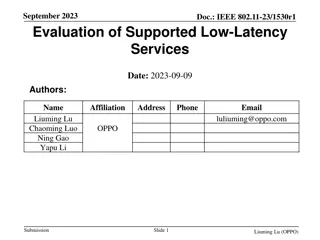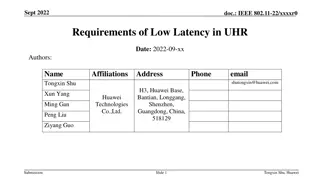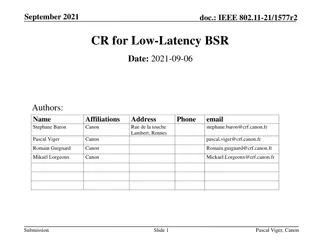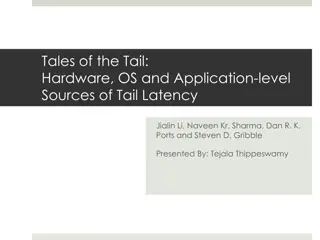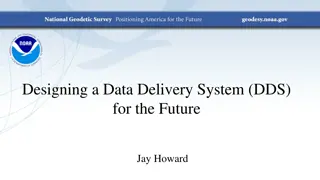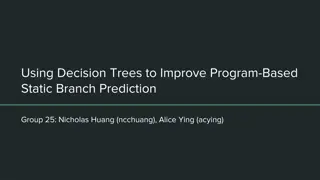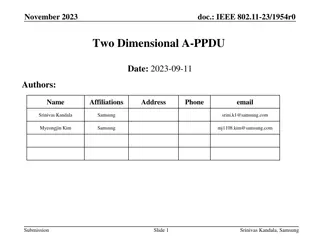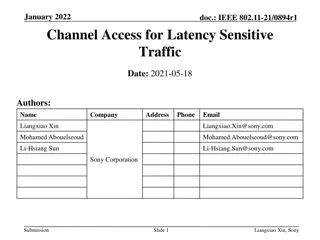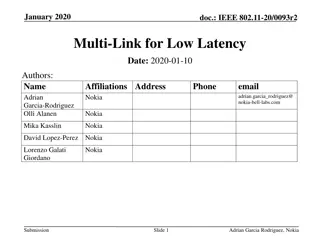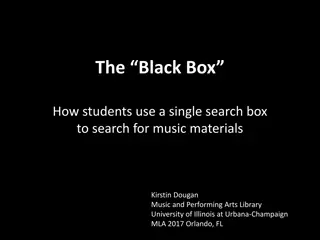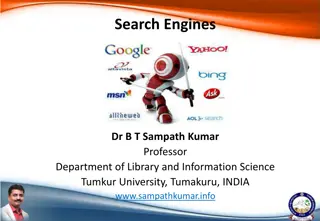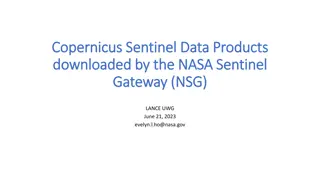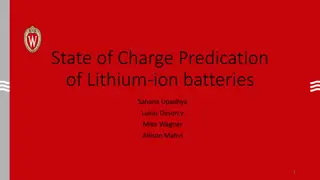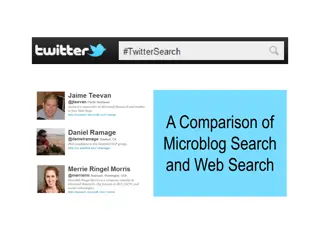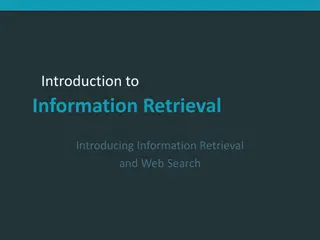Enhancing Web Search Latency with DDS Prediction
This presentation delves into DDS Prediction, a technique designed to reduce extreme tail latency in web search engines by optimizing query execution times and parallelizing specific queries. It addresses the challenges of improving latency for all users and emphasizes the importance of achieving high quality search results with minimal delays. The talk also highlights the significance of reducing end-to-end latency and optimizing resource parallelization to enhance overall search performance.
Download Presentation

Please find below an Image/Link to download the presentation.
The content on the website is provided AS IS for your information and personal use only. It may not be sold, licensed, or shared on other websites without obtaining consent from the author. Download presentation by click this link. If you encounter any issues during the download, it is possible that the publisher has removed the file from their server.
E N D
Presentation Transcript
Delayed-Dynamic-Selective (DDS) Prediction for Reducing Extreme Tail Latency in Web Search Saehoon Kim , Yuxiong He*, Seung-won Hwang , Sameh Elnikety*, Seungjin Choi * 1
Web Search Engine Requirement Queries High quality + Low latency This talk focuses on how to achieve low latency without compromising the quality 2
Low Latency for All Users Reduce tail latency (high-percentile response time) Reducing average latency is not sufficient Latency Commercial search engine reduces 99th- percentile latency 3
Reducing End-to-End Latency The 99th percentile response time < 120ms Aggregator 40 Index Server Nodes (ISNs) ISN ISN ISN ISN The 99.99th percentile response time < 120ms Long(-running )query 4
Reducing Tail Latency by Parallelization Resource Latency Opportunity of Parallelization 1. Available idle cores 2. CPU-intensive workloads Network 4.26 ms Queueing 0.15 ms I/O 4.70 ms CPU 194.95 ms 5
Challenges of Exploiting Parallelism Parallelizing all queries Inefficient under medium to high load Parallelizing short queries No speed up Parallelizing long queries Good speed up Parallelize only long(-running) queries 6
Prior Work - PREDictive Parallelization Predict the query execution time Parallelize the predicted long queries only Execute the predicted short queries sequentially WSDM Long Feature Extraction Regression function Prediction model Short Predictive Parallelization: Taming Tail Latencies in Web Search, [M. Jeon, SIGIR 14] 7
Requirements 99th tail latency at aggregator <= 120ms Reduce 99.99th tail latency at each ISN <= 120ms Recall >= 98.9% Precision Should be high Less queries to be parallelized 1.1% Requirements To optimize 99.99th tail latency 98.9% Reason PRED PRED cannot effectively reduce 99.99th tail latency 8
Contributions Key Contributions: 1. Proposes DDS (Delayed-Dynamic-Selective) prediction to achieve very high recall and good precision 2. Use DDS prediction to effectively reduce extreme tail latency 9
Overview of DDS Selective prediction Delayed prediction Not confident Predictor for confidence level Queries > 10ms Query Long Dynamic prediction Queries < 10ms Predictor for execution time Finished Short 10
Delayed Prediction 1) Complete many short queries sequentially 2) Collect dynamic features 11
Dynamic Features What are dynamic features? Features that can only be collected at runtime Two categories NumEstMatchDocs: to estimate the total # matched docs DynScores: to predict early termination 12
Primary Factors for Execution Time 1. # total matched documents Lowest Docs sorted by static scores Highest Web Doc 1 Doc 2 Doc 3 . Doc N-2 Doc N-1 Doc N documents . . Inverted index for WSDM Inverted index for 2015 Processing 13
Primary Factors for Execution Time 1. # total matched documents Lowest Docs sorted by static scores Highest Web Doc 1 Doc 2 Doc 3 . Doc N-2 Doc N-1 Doc N documents . . Inverted index for WSDM Inverted index for 2015 Processing Not evaluated 2. Early termination 14
Early Termination Lowest Docs sorted by static scores Highest Web Doc 1 Doc 2 Doc 3 . Doc N-2 Doc N-1 Doc N documents . . Inverted index for WSDM Processing Not evaluated Doc ID Doc ID Doc ID Doc ID Dynamic Score Dynamic Score Dynamic Score Dynamic Score To predict early termination, If min. Dynamic score > threshold, then stop. Top-3 Results Consider a dynamic score distribution Doc 1 Doc 3 Doc 3 Doc 3 -4.11 -4.01 -4.01 -4.01 Doc 1 Doc 1 Doc 8 -4.11 -4.11 -4.10 Doc 5 Doc 1 -4.23 -4.11 15
Importance of Dynamic Features Top-10 feature importance by boosted regression tree NumEstMachDoc helps to predict # total matched docs DynScore helps to predict early termination 16
Selective Prediction Find out almost all long queries with good precision Identify the outliers (long query predicted as short) Predicted execution time 17
Selective Prediction Long queries Predicted ?1 error Short queries Predicted execution time 18
Overview of DDS Selective prediction Delayed prediction Not confident Predictor for confidence level Queries > 10ms Query Long Dynamic prediction Queries < 10ms Predictor for execution time Finished Short 19
Evaluations of Predictor Accuracy (1/3) Baseline (PRED) Static features with no delayed prediction IDF, Static score (e.x. PageRank), etc. Proposed method (DDS) Dynamic (+static) features with Delayed and Selective prediction 20
Evaluations of Predictor Accuracy (2/3) 69,010 Bing queries at production workload 14,565 queries >= 10ms 635 queries >= 100ms Boosted regression tree with 10-fold cross validation For PRED, we use 69,010 queries For DDS, we use 14,565 queries 21
Evaluations of Predictor Accuracy (3/3) 957% Improvement over PRED 22
Evaluations of Predictor Accuracy (3/3) 957% Improvement over PRED Delayed 23
Evaluations of Predictor Accuracy (3/3) 957% Improvement over PRED Selective features Dynamic features Delayed 24
Simulation Results on Tail Latency Reduction Baseline (PRED) Predict query execution time before running it Parallelize the long query with 4-way parallelism Proposed method (DDS) Run a query for 10ms sequentially Parallelizes the long or unpredictable queries with 4-way parallelism 25
ISN Response Time 70% throughput increase 28
Aggregator Response Time DDS can optimize 99th-percentile tail latency at aggregator under high QPS 29
Conclusion Proposes a novel prediction framework Delayed prediction/Dynamic features/Selective prediction Achieves a high precision and recall compared to PRED Reduces 99th-percentile aggregator response time <= 120ms under high load! 30



